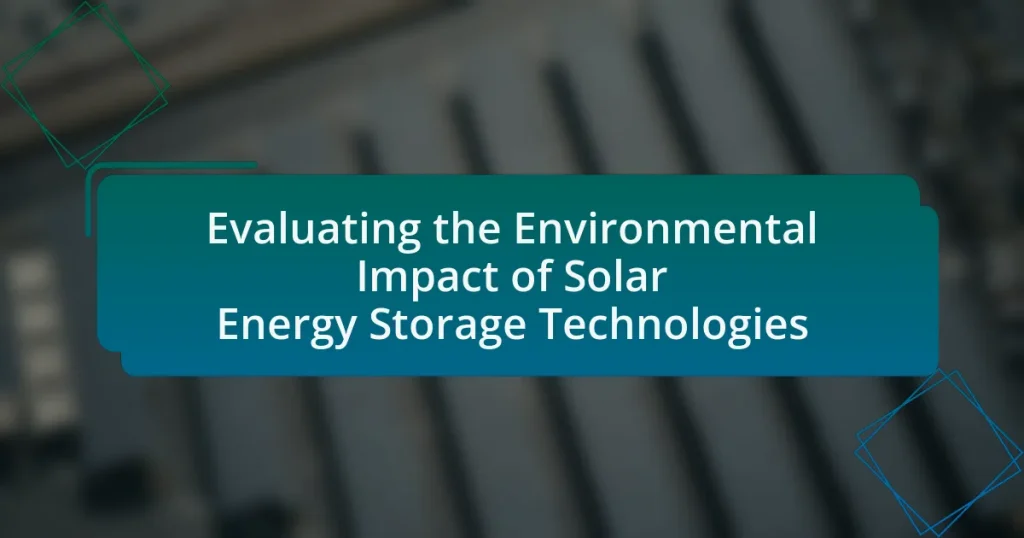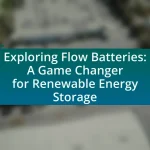Solar energy storage technologies are systems designed to capture and store energy generated from solar power for later use, including batteries, pumped hydro storage, thermal storage, and flywheels. This article evaluates the environmental impact of these technologies, discussing their functionality, types, and importance for sustainability. It examines the lifecycle emissions associated with solar energy storage, the environmental consequences of material extraction and disposal, and the challenges in assessing their impacts. Additionally, it highlights best practices and policies that can enhance sustainability in solar energy storage, emphasizing the need for collaboration among stakeholders to promote environmentally friendly technologies.
What are Solar Energy Storage Technologies?
Solar energy storage technologies are systems that capture and store energy generated from solar power for later use. These technologies include batteries, pumped hydro storage, thermal storage, and flywheels, each serving to balance supply and demand by storing excess energy produced during sunny periods for use during times of low production or high demand. For instance, lithium-ion batteries are widely used due to their efficiency and decreasing costs, with prices dropping by approximately 89% from 2010 to 2020, according to BloombergNEF. This significant reduction in cost has made solar energy storage more accessible and viable for residential and commercial applications, thereby enhancing the overall effectiveness of solar energy systems.
How do Solar Energy Storage Technologies function?
Solar energy storage technologies function by capturing and storing energy generated from solar panels for later use. These systems typically utilize batteries, such as lithium-ion or flow batteries, to store excess energy produced during peak sunlight hours. When sunlight is not available, such as during the night or cloudy days, the stored energy can be released to power homes or businesses.
The efficiency of these technologies is evidenced by the rapid growth of the global battery storage market, which was valued at approximately $9.5 billion in 2020 and is projected to reach $23.4 billion by 2027, according to a report by Fortune Business Insights. This growth reflects the increasing adoption of solar energy systems paired with storage solutions, highlighting their critical role in enhancing energy reliability and reducing dependence on fossil fuels.
What types of technologies are used for solar energy storage?
The main types of technologies used for solar energy storage include lithium-ion batteries, flow batteries, pumped hydro storage, and thermal energy storage. Lithium-ion batteries are widely utilized due to their high energy density and efficiency, making them suitable for residential and commercial applications. Flow batteries, which store energy in liquid electrolytes, offer scalability and long-duration storage capabilities. Pumped hydro storage, the most established method, uses gravitational potential energy by pumping water to a higher elevation during excess energy production and releasing it to generate electricity when needed. Thermal energy storage systems, such as molten salt, store heat generated from solar energy for later use, particularly in concentrated solar power plants. These technologies collectively enhance the reliability and efficiency of solar energy systems, facilitating a transition to renewable energy sources.
How do these technologies convert and store energy?
Solar energy storage technologies convert energy through photovoltaic cells that capture sunlight and convert it into electricity. This electricity can then be stored in batteries or other storage systems, such as pumped hydro storage or thermal storage, for later use. For instance, lithium-ion batteries, commonly used in solar energy systems, store electrical energy chemically, allowing for efficient energy retrieval when needed. According to the U.S. Department of Energy, the efficiency of these systems can exceed 90%, demonstrating their effectiveness in energy conversion and storage.
Why are Solar Energy Storage Technologies important for sustainability?
Solar energy storage technologies are crucial for sustainability because they enable the efficient use of renewable energy by storing excess energy generated during peak production times for later use. This capability helps to balance supply and demand, reducing reliance on fossil fuels and minimizing greenhouse gas emissions. For instance, according to the International Renewable Energy Agency, energy storage can increase the share of renewables in the energy mix, facilitating a transition to a low-carbon economy. By allowing for energy availability even when solar generation is low, these technologies enhance grid stability and promote energy independence, further supporting sustainable development goals.
What role do they play in renewable energy integration?
Energy storage technologies play a crucial role in renewable energy integration by enabling the efficient use of intermittent energy sources like solar and wind. These technologies store excess energy generated during peak production times and release it during periods of low generation or high demand, thus stabilizing the energy supply. For instance, according to the International Renewable Energy Agency, energy storage can increase the share of renewables in the energy mix by providing grid stability and flexibility, which is essential for managing the variability of solar energy production.
How do they contribute to reducing greenhouse gas emissions?
Solar energy storage technologies contribute to reducing greenhouse gas emissions by enabling the efficient use of renewable energy, which displaces fossil fuel consumption. By storing excess solar energy generated during peak sunlight hours, these technologies allow for energy use during periods of low solar production, thus minimizing reliance on carbon-intensive energy sources. For instance, a study by the National Renewable Energy Laboratory found that integrating energy storage with solar power can reduce greenhouse gas emissions by up to 80% compared to traditional fossil fuel systems. This significant reduction is achieved as energy storage systems facilitate a more stable and reliable supply of clean energy, ultimately leading to lower overall emissions in the energy sector.
What are the Environmental Impacts of Solar Energy Storage Technologies?
The environmental impacts of solar energy storage technologies primarily include resource extraction, energy consumption during manufacturing, and end-of-life disposal issues. The production of batteries, particularly lithium-ion batteries, requires mining for materials such as lithium, cobalt, and nickel, which can lead to habitat destruction and water pollution. For instance, lithium extraction in South America has been linked to significant water depletion in local ecosystems.
Additionally, the manufacturing process of these storage systems is energy-intensive, contributing to greenhouse gas emissions if fossil fuels are used in the energy mix. According to a study published in the journal “Nature Communications,” the lifecycle emissions of lithium-ion batteries can be substantial, depending on the energy sources used during production.
Finally, the disposal and recycling of solar energy storage technologies pose environmental challenges. Improper disposal can lead to toxic chemical leaching into soil and water systems. However, advancements in recycling technologies are being developed to mitigate these impacts, aiming to recover valuable materials and reduce waste.
How do the materials used in these technologies affect the environment?
The materials used in solar energy storage technologies significantly affect the environment through resource extraction, production processes, and end-of-life disposal. For instance, lithium-ion batteries, commonly used in solar storage, require lithium, cobalt, and nickel, which are often mined in ways that lead to habitat destruction, water pollution, and significant carbon emissions. A study by the International Energy Agency in 2021 highlighted that lithium extraction can consume large amounts of water, impacting local ecosystems and communities. Additionally, the production of these materials involves energy-intensive processes that contribute to greenhouse gas emissions. Finally, improper disposal of batteries can lead to soil and water contamination due to toxic substances, emphasizing the need for sustainable recycling practices.
What are the environmental consequences of mining and processing these materials?
Mining and processing materials for solar energy storage technologies lead to significant environmental consequences, including habitat destruction, soil degradation, and water pollution. The extraction of lithium, cobalt, and nickel, essential for batteries, often results in deforestation and loss of biodiversity, as seen in regions like the Amazon rainforest where mining activities disrupt ecosystems. Additionally, the processing of these materials can release toxic substances into water sources, impacting local communities and wildlife. For instance, a study published in the journal “Environmental Science & Technology” highlights that lithium extraction in South America has led to increased salinity in water bodies, adversely affecting aquatic life. These consequences underscore the need for sustainable practices in the mining and processing of materials used in solar energy storage.
How do the disposal and recycling processes impact the environment?
The disposal and recycling processes significantly impact the environment by influencing waste management and resource conservation. Improper disposal of materials, particularly hazardous waste from solar energy storage technologies, can lead to soil and water contamination, harming ecosystems and human health. Conversely, effective recycling processes reduce the need for raw material extraction, thereby conserving natural resources and minimizing energy consumption. For instance, recycling lithium-ion batteries can recover up to 95% of lithium, cobalt, and nickel, which mitigates the environmental footprint associated with mining these materials. Additionally, recycling reduces greenhouse gas emissions by decreasing the energy required for producing new materials, thus contributing to a lower overall environmental impact.
What are the lifecycle emissions associated with Solar Energy Storage Technologies?
Lifecycle emissions associated with solar energy storage technologies primarily include greenhouse gas emissions generated during the manufacturing, transportation, installation, operation, and decommissioning phases. For instance, lithium-ion batteries, commonly used in solar energy storage, have an estimated lifecycle emission of approximately 150 to 200 grams of CO2 equivalent per kilowatt-hour (gCO2e/kWh) produced. This figure encompasses emissions from mining raw materials, battery production, and eventual disposal or recycling. Additionally, studies indicate that the overall lifecycle emissions for solar energy systems, including storage, can be significantly lower than fossil fuel-based energy systems, often ranging from 20 to 60 gCO2e/kWh, depending on the technology and location. These emissions are critical for assessing the environmental impact of solar energy storage technologies.
How do emissions vary across different storage technologies?
Emissions vary significantly across different storage technologies, with lithium-ion batteries generally producing lower emissions compared to lead-acid batteries and pumped hydro storage. Lithium-ion batteries have a lifecycle emissions estimate of approximately 150-200 grams of CO2 equivalent per kilowatt-hour, while lead-acid batteries can exceed 300 grams of CO2 equivalent per kilowatt-hour due to their manufacturing and disposal processes. Pumped hydro storage, while having a lower operational carbon footprint, can still result in emissions related to construction and land use changes, averaging around 10-50 grams of CO2 equivalent per kilowatt-hour. These variations highlight the importance of selecting storage technologies based on their environmental impact, particularly in the context of solar energy integration.
What measures can be taken to minimize lifecycle emissions?
To minimize lifecycle emissions, implementing energy-efficient manufacturing processes is essential. These processes can significantly reduce emissions during the production phase of solar energy storage technologies. For instance, using renewable energy sources in manufacturing can lower the carbon footprint associated with energy consumption. Additionally, selecting materials with lower embodied energy, such as recycled metals, can further decrease emissions throughout the lifecycle. Research indicates that optimizing supply chains and logistics can also contribute to emission reductions by minimizing transportation-related emissions. According to a study published in the journal “Renewable Energy,” lifecycle assessments of solar technologies show that improvements in production efficiency and material selection can lead to a reduction of up to 30% in overall lifecycle emissions.
What are the Challenges in Evaluating the Environmental Impact?
The challenges in evaluating the environmental impact of solar energy storage technologies include the complexity of lifecycle assessments, variability in technology performance, and the difficulty in quantifying indirect environmental effects. Lifecycle assessments require comprehensive data on resource extraction, manufacturing, usage, and disposal, which can be inconsistent or incomplete. Variability in technology performance, influenced by factors such as location and operational conditions, complicates the ability to generalize findings. Additionally, quantifying indirect effects, such as changes in land use or impacts on local ecosystems, poses significant challenges due to the interconnected nature of environmental systems. These factors collectively hinder accurate and reliable evaluations of environmental impacts.
How do different assessment methodologies affect the evaluation?
Different assessment methodologies significantly influence the evaluation of environmental impacts by providing varied frameworks and metrics for analysis. For instance, life cycle assessment (LCA) offers a comprehensive view by evaluating the environmental effects of solar energy storage technologies from raw material extraction to disposal, allowing for a holistic understanding of their sustainability. In contrast, cost-benefit analysis focuses primarily on economic factors, potentially overlooking critical environmental aspects. Research by Finnveden et al. (2009) in “Life Cycle Assessment: Past, Present, and Future” highlights that the choice of methodology can lead to different conclusions regarding the environmental performance of technologies, emphasizing the importance of selecting an appropriate assessment approach to accurately reflect the impacts.
What are the limitations of current environmental impact assessments?
Current environmental impact assessments (EIAs) have several limitations, including a lack of comprehensive data, inadequate consideration of cumulative impacts, and insufficient stakeholder engagement. These assessments often rely on outdated or incomplete information, which can lead to inaccurate evaluations of potential environmental effects. Additionally, EIAs frequently fail to account for the cumulative impacts of multiple projects over time, which can significantly alter ecosystems. Furthermore, the engagement of local communities and stakeholders in the assessment process is often minimal, resulting in overlooked local knowledge and concerns. These limitations can hinder the effectiveness of EIAs in accurately predicting and mitigating environmental impacts associated with projects, including those related to solar energy storage technologies.
How can these methodologies be improved for better accuracy?
Methodologies for evaluating the environmental impact of solar energy storage technologies can be improved for better accuracy by incorporating more comprehensive life cycle assessments (LCAs) that account for all stages of production, use, and disposal. Enhanced LCAs can provide a clearer picture of the environmental footprint by including factors such as resource extraction, manufacturing processes, operational efficiency, and end-of-life management. Research indicates that traditional assessments often overlook significant emissions and resource use during these phases, leading to underestimations of environmental impacts. For instance, a study published in the journal “Renewable and Sustainable Energy Reviews” highlights that integrating regional environmental data and specific material flows can refine impact assessments, resulting in more accurate evaluations of solar energy storage technologies.
What are the key factors influencing the environmental impact evaluation?
The key factors influencing environmental impact evaluation include the type of technology used, resource consumption, emissions, land use, and lifecycle analysis. The technology type determines the specific environmental risks and benefits associated with solar energy storage systems. Resource consumption refers to the materials and energy required for production, which can impact ecosystems and resource availability. Emissions during manufacturing, operation, and disposal phases contribute to the overall environmental footprint. Land use considerations involve the impact on local habitats and biodiversity. Lifecycle analysis assesses the environmental effects from production to disposal, providing a comprehensive view of sustainability. These factors collectively shape the evaluation process and outcomes for solar energy storage technologies.
How do geographical and climatic conditions play a role?
Geographical and climatic conditions significantly influence the efficiency and effectiveness of solar energy storage technologies. Regions with high solar irradiance, such as deserts, maximize energy capture, while areas with frequent cloud cover or precipitation reduce solar energy generation. For instance, solar panels in locations like the Mojave Desert can achieve higher energy outputs compared to those in temperate climates, where sunlight is less consistent. Additionally, temperature variations affect battery performance; extreme heat can degrade battery life, while cold temperatures can reduce energy storage capacity. Studies indicate that optimizing solar energy systems according to local geographical and climatic factors can enhance overall energy efficiency and sustainability.
What is the significance of technological advancements in reducing impacts?
Technological advancements are significant in reducing environmental impacts by enhancing the efficiency and sustainability of energy systems. For instance, innovations in solar energy storage technologies, such as lithium-ion batteries, have improved energy retention and reduced waste, leading to lower greenhouse gas emissions. According to a study by the International Renewable Energy Agency, advancements in battery technology can decrease the lifecycle emissions of solar energy systems by up to 30%. This demonstrates that technological progress not only optimizes energy use but also plays a crucial role in mitigating climate change effects.
What best practices can be adopted for minimizing environmental impacts?
To minimize environmental impacts, adopting best practices such as using sustainable materials, implementing efficient recycling processes, and optimizing energy consumption is essential. Sustainable materials reduce resource depletion and pollution, while efficient recycling processes can significantly lower waste and energy use associated with production. For instance, the use of recycled materials in solar energy storage systems can decrease the demand for virgin resources, thereby minimizing environmental degradation. Additionally, optimizing energy consumption through advanced technologies can lead to lower greenhouse gas emissions, contributing to a more sustainable energy landscape.
How can stakeholders collaborate to enhance sustainability in solar energy storage?
Stakeholders can collaborate to enhance sustainability in solar energy storage by forming partnerships that focus on research, technology development, and policy advocacy. Collaborative research initiatives can lead to innovative storage solutions that minimize environmental impact, such as developing more efficient battery technologies that use sustainable materials. For example, the National Renewable Energy Laboratory has highlighted the importance of joint efforts in advancing battery recycling methods, which can significantly reduce waste and resource consumption. Additionally, stakeholders can engage in policy advocacy to promote regulations that incentivize sustainable practices in solar energy storage, ensuring that environmental considerations are integrated into industry standards. This multifaceted collaboration not only drives technological advancements but also aligns economic interests with environmental sustainability goals.
What policies can support the development of environmentally friendly technologies?
Policies that can support the development of environmentally friendly technologies include financial incentives, regulatory frameworks, and research funding. Financial incentives, such as tax credits and grants, encourage businesses and individuals to invest in green technologies by reducing upfront costs. Regulatory frameworks, including emissions standards and renewable energy mandates, create a market for environmentally friendly technologies by ensuring compliance and promoting sustainable practices. Research funding from government and private sectors fosters innovation in clean technology, leading to advancements in efficiency and effectiveness. For instance, the U.S. Department of Energy’s Solar Energy Technologies Office has invested over $1 billion in solar energy research, demonstrating the impact of targeted funding on technology development.


